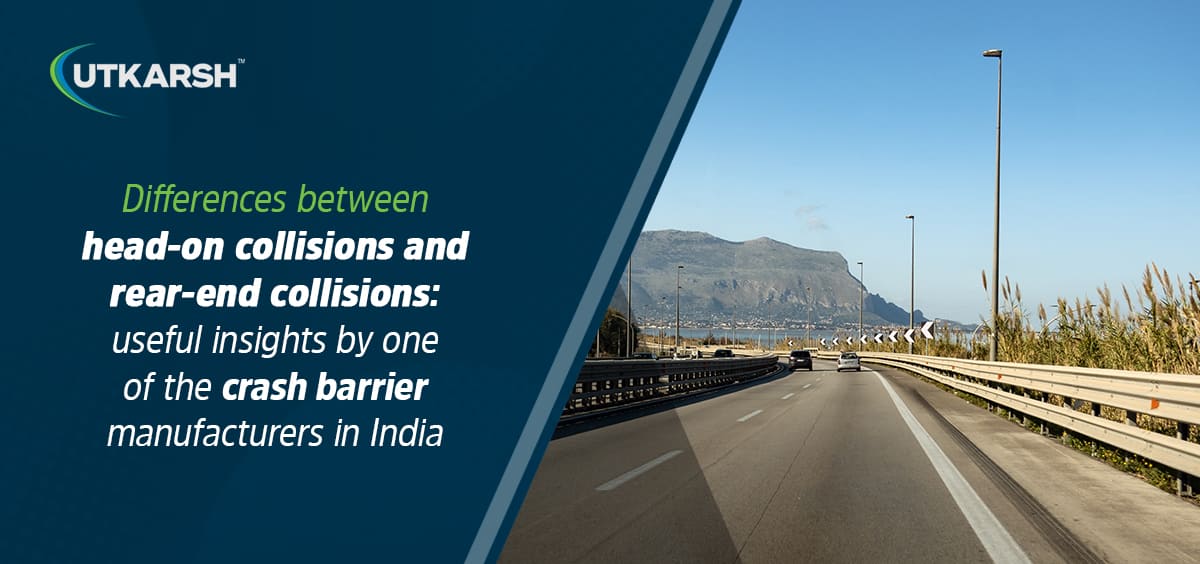Differences between head-on collisions and rear-end collisions: useful insights by one of the crash barrier manufacturers in India

On-road collisions can be devastating for all people involved. Depending on the speed and angle of impact, some collisions are more dangerous than others. The most common types are rear-end collisions and head-on collisions. As one of the leading crash barrier manufacturers in India, we share the distinctions between these two types of collisions when it comes to causes and prevention methods:
Head-on collisions
Head-on collisions are those instances where two vehicles crash with each other face to face. The force of the impact is directly absorbed by both vehicles and their occupants, often leading to severe injuries or death. Also, in these crashes, the drivers face immense risk of injury or even death.
Causes:
- Wrong-way driving: This is a common cause of such collisions when a vehicle enters a one-way road facing the opposite direction of traffic flow.
- Overtaking: Trying to overtake a vehicle in front of them could take drivers in the wrong lane. Since in these lanes the traffic flow is in the opposite direction, it could lead to head-on collisions.
- Distracted or impaired driving: Distraction or impairment can cause a driver to drift into the opposing lane, leading to a head-on collision.
Preventive strategies:
- Roadway design: The presence of crash barriers between two lanes can prevent accidental or intentional driving in the wrong lane. Similarly, marking the lanes clearly is another way to avoid such mishaps.
- Public awareness campaigns: There should be regular community outreach programmes to educate drivers on the dangers of driving in a tired, distracted or impaired state.
Rear-end collisions:
Rear-end collisions, as the name suggests, occur when one vehicle crashes into the rear-end of another vehicle. Generally, these collisions occur at lower speeds and may inflict lesser degree of injuries to the occupants. Although generally less severe than head-on collisions, the severity can still vary widely depending on factors such as speed, size of the vehicles involved, and whether the occupants are wearing seatbelts.
Causes:
- Tailgating: This is the practice of following a vehicle too closely. If there is minimal gap between two vehicles, it reduces the reaction time for the vehicle following in case the leading car applies a sudden brake.
- Sudden stops: When a vehicle stops abruptly, even at traffic lights, they can cause a domino effect in the vehicles behind them. This can cause multiple rear-end collisions.
- Poor weather conditions: During intense rain, storm or other weather activities, drivers may suffer from reduced visibility. To make matters worse, wet or slippery roads can lead to the vehicle brakes taking longer to engage. Such issues can cause rear-end collisions too.
Preventive strategies:
- Maintain safe following distances: Drivers should keep a safe distance from the vehicle in their front. This enables them to take evasive action should the leading vehicle stop all of a sudden.
- Defensive driving: Attentive drivers are able to anticipate when a vehicle in front of them is about to stop or apply the brakes. This anticipation will enable them to avoid crashing into the other vehicle during abrupt stops.
- Brake early: Drivers should signal in advance when they are about to stop their vehicles. This ensures that all following vehicles have plenty of time to manoeuvre their cars.
- Adaptive cruise control: Vehicles equipped with adaptive cruise control can automatically adjust speed to maintain a safe following distance.
Looking for high-quality metal beam crash barriers for your next project?
Explore our metal beam crash barriers. We manufacture a diverse range of barriers that meet Indian, American, European, and other international standards. We source our raw materials from trusted brands such as SAIL, TATA, and Hindustan Zinc to ensure the highest quality. Our rigorous quality control system is designed to guarantee that we deliver only the best products to our customers.
We offer a comprehensive range of W Beam Crash Barriers, Thrie Beam Crash Barriers, along with associated components and anchorage systems. Our products are manufactured and rigorously tested to conform to international standards. We provide fast delivery services all over India. Our barriers are hot-dip galvanised for extended durability, using special high-grade zinc (99.99%).
We are the preferred supplier for leading Infrastructure and EPC contractors and have a global client base that includes countries such as Qatar, Greece, Poland, Germany, and Australia. We strictly adhere to the guidelines set by the Ministry of Road Transport & Highways India (MORTH). We are also the only Indian company with real-time crash-tested barriers that passed the crash test on the first attempt.